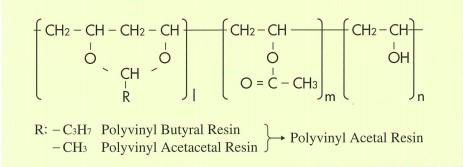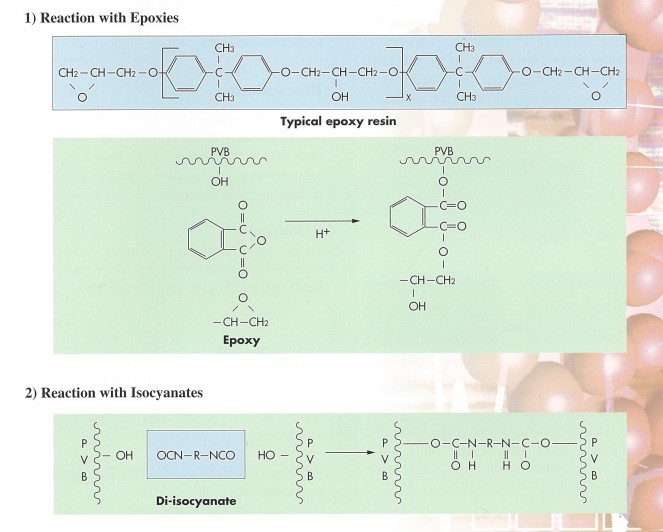High-performance resins hold a unique position in the landscape of modern industrial materials due to their superior comprehensive properties. Among many similar products, polyvinyl butyral resins S-LEC B and S-LEC K, with their unique and flexible chemical structures, have become key solutions in fields ranging from high-precision electronics manufacturing to specialty coatings.
S-LEC B was first introduced in the 1930s, initially used in industry as an interlayer film for safety glass, establishing its position among high-performance polymers. S-LEC K, as a functional extension of this series, focuses on applications with stringent requirements for heat resistance due to its high glass transition temperature (Tg). Although both are collectively referred to as the S-LEC B/K series, their performance differences are rooted in their sophisticated chemical structure design.
1. Core Chemical Structure: The Source of Performance
Both S-LEC B and S-LEC K are derived from polyvinyl alcohol (PVA). These are prepared by reacting PVA with specific aldehydes in a reaction called acetalization. Due to limitations in the manufacturing process, the acetalization reaction cannot be completed completely, resulting in the final resin molecular chain retaining three crucial structural units that collectively determine the final product's properties:


♠Acetal Unit: This is the core functional unit of the resin, imparting hydrophobicity and flexibility to the material. The fundamental difference between S-LEC B and S-LEC K lies in the side chain (R group) of this unit:
♣Hydroxyl Unit (OH):The unit refers to the part of PVA that hasn't reacted and remains within the resin molecule in a specific ratio. The hydroxyl group gives the resin good adhesion—particularly to polar surfaces like metals and glass—and makes it attract water. More crucially, this hydroxyl group lets the resin form cross-links with resins that harden when heated, like epoxy resins and isocyanates. This hardening broadens the resin's use.
♣Acetyl Unit: These trace units remain because of incomplete breakdown during PVA production.
The proportions of these three units in the molecular chain, precisely controlled through the manufacturing process, constitute the vast spectrum of the S-LEC B/K series resin grades.
2. Performance Regulation: A Precise Balance of Influencing Factors
The physical and chemical properties of this series of resins are not fixed but are precisely regulated by the following three core factors:
2.1 The Unity of Opposites and Hydroxyl Content
The acetal and hydroxyl content in the molecular structure usually exhibit an inverse relationship, and their balance directly determines the key properties of the resin:
2.2 The Decisive Role of Molecular Weight in Application Performance
The molecular weight (degree of polymerization) of the resin directly affects the following crucial application characteristics:
The S-LEC B/K series offers a wide molecular weight range, from approximately 14,000 to 130,000. Engineers can choose materials based on the needed viscosity, strength, and flexibility by picking different acetal contents.
2.3 Thermodynamic Properties: Tg and Heat Resistance Stability
The glass transition temperature (Tg) is a core indicator of a material's heat resistance. This series of resins covers a Tg range from 59°C to 110°C, enabling them to meet the needs of applications ranging from low-temperature applications requiring high flexibility to high-temperature applications requiring high stability:
3. Functional Expansion: Crosslinking Reaction and Thermosetting Potential

The S-LEC B/K series is not limited to use as a thermoplastic material. Because it has many hydroxyl groups, this substance can crosslink and cure when mixed with different thermosetting resins like phenolic resins, epoxy resins, or isocyanates. This crosslinking capability is a significant advantage in industrial applications, allowing engineers to combine the superior toughness, adhesion, and flexibility of thermoplastic resins with the high heat resistance, chemical resistance, and mechanical strength of thermosetting resins through formulation design. The result is composite materials that perform well, overcoming the limits of single resins. For instance, this crosslinking and curing process is key to achieving the needed performance in high-end coatings and adhesives.
S-LEC B and S-LEC K resins are important types of high-performance polymers. These resins are valued because their properties, like flexibility and adhesion, can be adjusted. This is achieved by carefully managing the acetal side chains (using butyraldehyde or acetaldehyde) and the amount of hydroxyl content in the resin. This meticulous control over molecular structure ensures that S-LEC B/K can continuously provide high-performance material solutions for multiple key industrial sectors, including electronics, automotive, coatings, and adhesives.
Website: www.elephchem.com
Whatsapp: (+)86 13851435272
E-mail: admin@elephchem.com